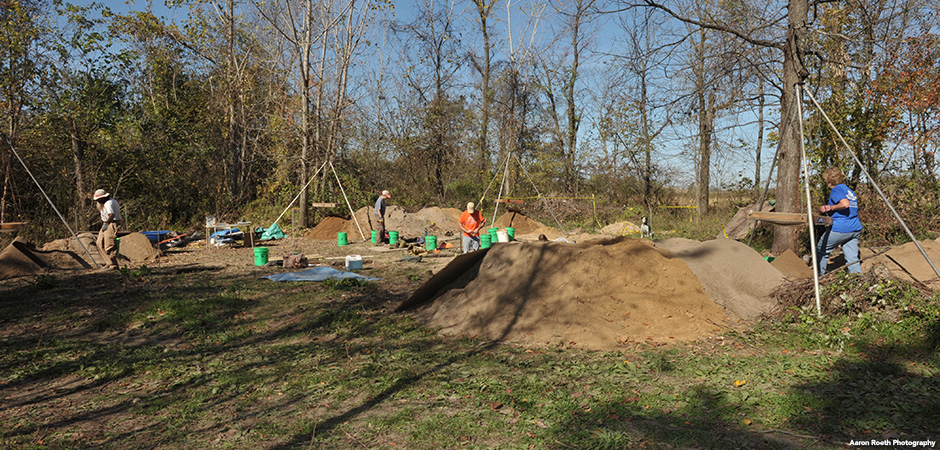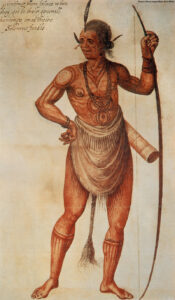
Nearly 25 years before English colonists established their first permanent settlement in North America, Phillip Amadas and Arthur Barlowe explored the continent. They brought back to England stories of fruitful land and friendly people. In a detailed account, Amadas and Barlowe described their meetings with the Algonquian people.
On Roanoke Island in present-day North Carolina, the Algonquians welcomed Amadas, Barlowe, and members of their ships’ crew to their village of nine houses. The houses were built of cedar and surrounded by trees for protection. In April 2023, more than 400 years after that historic event, archaeologists used ground-penetrating radar to try to find the actual site of the Native American village.
Below btw takes a closer look at the journey of Amadas and Barlowe, their stories of the Algonquians, and the historical impact of a new discovery.
Finding New Land
On April 27, 1584, Amadas and Barlowe sailed two ships from England. Sir Walter Raleigh hired the men to explore the land of present-day North America. Queen Elizabeth I granted Raleigh, a wealthy English gentleman, the right to explore and claim any North American lands not already claimed by Europeans. Raleigh wanted to start an English settlement in North America but first needed information about the unknown territory.
Amadas and Barlowe completed their journey across the Atlantic Ocean on July 13, 1584. They sat aboard their anchored ships for two days. Then, on the third day, they spotted three men in a canoe.
‘Kind, Loving’ People
The English met with the Algonquian people who had lived on the land long before Europeans arrived. One of them came aboard the ship and was given wine, food, and clothing. The next day, the English explorers met with a larger group of Algonquin. They established friendly relations with them. “A more kind and loving people cannot be found in the world,” they said of the Native Americans.

For several weeks, Amadas and Barlowe traded with the Algonquians and toured their land. In exchange for Algonquian corn, fruits, animals, beans, and wheat, the English traded their goods. Because of disagreements with neighboring Native Americans, the Algonquians wanted the Englishmen’s swords. Amadas and Barlowe refused that request, but they did exchange hatchets, axes, and knives. They also described how an Algonquin repurposed a tin dish as body armor. A hole was drilled so it could be tied around an Algonquian warrior’s neck and draped across his chest to prevent injury from a bow and arrow attack. During one inland journey, the Algonquians welcomed the visitors to their village. There, the Englishmen were fed and entertained. These accounts were published in Richard Hakluyt’s 1589 book titled, The Principall Navigations, Voiages and Discoveries of the English Nation.
To England and Back
Amadas and Barlowe returned to England in September 1584 with Native American food, two Algonquians named Manteo and Wanchese, and detailed descriptions of the land and people. Of the soil, they said it “is most plentiful, sweet, fruitful and wholesome of all the world.” Historians have said that Amadas and Barlowe might have exaggerated their stories so Raleigh could encourage settlers to America.
If so, it worked. Less than a year later, more than 100 English settlers under Sir Richard Greenville left for Roanoke. However, the settlement did not last. The entire group returned to England a year later. But a second group of 118 men, women, and children came back to Roanoke in July 1587. That would become the famous Lost Colony of Roanoke, which disappeared without a trace. Twenty years later, the English established a lasting colony at Jamestown, Virginia. Jamestown is about 150 miles northwest of Roanoke Island.
Does The Village Still Exist?
Archaeologists are hoping to learn more about Amadas and Barlowe’s visit with the Algonquians by using modern technology. They recently used ground-penetrating radar to study what is nine feet below ground. Robert Chartrand, an archaeologist leading the project, will turn the radar data into a three-dimensional view of the site. The data then will be used to decide whether to fund an excavation of the land. The decision is expected to be made by June 2023.
